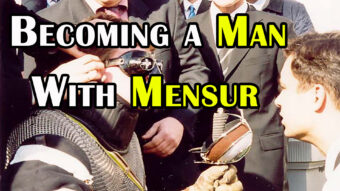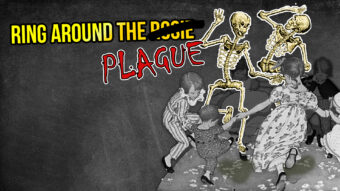
The answer to the first question is a clear ‘yes’. Loud noises can actually directly harm or even kill you.
Beyond the obvious of a loud noise distracting you or causing you to be startled to the extent that you, say, jump and smack your head on something causing irrevocable brain damage or the like, very loud noise can also, of course, cause damage to our tissues. For example, exposure to sounds over 150 decibels, would typically result in the bursting of your eardrums. To understand how this would work we should think of what noise is.
Decibels (named for Alexander Graham Bell) is a unit of sound pressure level. Acoustic energy is after all just waves of varying sound pressure. The higher the energy the higher the sound. It’s important to understand that each decibel level translates to a micropascal value (pascal being the S.I. standard unit of pressure) and it’s not a linear progression. So if 20 micropascals (for a given standard reference is) 60 dB, doubling the pressure, i.e. 40 micropascals is 66 Decibels.
Generally, human speach is around 60 decibels, and a chainsaw is around 110 dB. As noted, the eardrums will be damaged at values around 150. This is the level of noise you would find close up around a jet aircraft during take-off.
There is of course even louder noises, for example near a rocket lunch you might find sounds in excess of 170 dB. As you might have guessed from all of this, even louder sounds, i.e. pressure waves capable of crushing the body, will not be perceived, or at least not for long, through the already destroyed ear drums, but could cause an air embolism in your lungs, which then travels to your heart and kills you. Alternatively, your lungs might simply be significantly damaged from the sudden increase in air pressure.
Naturally experiments to see what humans can take here are rather scarce, but experiments on our little fury friends indicate that, for example, lung and other tissue damage, including damage to internal organs, occurs at just over 180 dB and becomes quite deadly at not far beyond that.
So are there such devices designed in such a way to kill people? Given the experiments done on mice, you will be unsurprised to learn that the answer is yes, such as one developed by the European space agency. Of course, murdering humans wasn’t exactly the point of making theirs… or so our lizard overlords, by Grabthar’s hammer may they reign forever, would have you believe. For those who refuse to see the truth, the agency’s primary reason for building the machine was to use on satellites. You see, as noted, when a rocket takes off it is, well, extremely loud owing to vibrations of the air molecules caused after some form of release of energy. As you might expect, these vibrations can often be harmful for the delicate electronics and other parts of any satellite cargo. Various methods are used to get around the problem. For example, in order to help dampen the high noise one method is to pour immense amounts of water on the platform during launch, on the order of 300 thousand gallons or so… Better, of course, is to simply build satellites capable of taking such a sound wave beating. Thus, a dedicated system was built to produce sounds at extremely high decibel levels to test satellites with. A perfectly innocent use for this killer sound machine.
Beyond this, there are of course weapons specifically built to utilize the weaknesses of the human sense of hearing, so-called ‘sound canons’ and of course the famous ‘mosquito’ sonic devise. As for the former, these sonic devices usually work by producing highly directional ‘sound cones’ of very loud audible sound. Ideally, if you stand just outside the cone you hear nothing or very little. These devices are mainly used by police or military to target unwanted or dangerous gatherings in order to help disperse them.
But what about the mosquito devise? This one targes the bane of all human existence, the dreaded teenager. The acoustic range of the human ear is generally defined as 20 Hz to 20KHz but that’s just a ballpark range. In fact, the older you are, the narrower the range, helping ensure the more wizened among us don’t have to listen to crickets asking for sex all night long. On the other side of things, little human parasites are typically able to hear higher frequencies than the adults they leach off of. Enter the Mosquito sonic devise, designed to emit sounds in frequencies teens and younger can hear, helping to disperse teenagers loitering around shops or other such places where they aren’t wanted.
Speaking of teenagers, this all brings us to deadly smells.
Whether or not a material can have a smell is dependent on how easily it can enter a gaseous state. This is called being volatile. As heat and in some cases humidity can increase the chemical activity of many materials, they are more likely to give off a scent when warmed or dissolved.
This is where the nose comes in. Within it, the so-called olfactory epithelium can be found, and it is normally covered with mucus. This mucus helps dissolve fragrant particles – and so the olfactory receptor cells can really begin doing their job. These exist in abundance; each nose has around four million of them. As with most cells, they are further specialized and can belong to one of about 400 different types, which can only detect one particular smell. Not everyone has all types of receptor cells; therefore it depends on genetics whether or not a person can smell a particular odor.
A research team based in the University of Manchester has for example been able to determine that homo sapiens and his far relatives Neanderthals and Denisovans share the ability to identify the scent of pigs and their ancestors, bringing to the foreground how evolutionarily important these animals must have been to their respective diet.
Smell in particular has the additional curious trait of being closely connected with emotional association. This is the case because the part of the brain whose function it is to sort out smells, the olfactory bulb, belongs to the limbic system, which is responsible for how we behave, our moods and emotional responses, and even memory and learning.
But as nice as it is that the scent of a particular brand of tobacco might involuntarily make one fondly remember a deceased great-grandfather, what is of interest to the topic at hand is the function of olfaction as a warning mechanism.
When an odor is identified as bad, the body reacts without consulting you first. Depending on just how terrible the smell is, how close you are to the source, and how dangerous your brain deems that smell, you may experience the following.
At first, your nostrils may flare. If the scent is faint, this is to draw in more of it in order to determine what it is. Your nose may wrinkle – closing half of your membranes to avoid further exposure – and your facial muscles contract to signify disgust to the humans around you, also warning them. You may automatically hold your breath until you can get away from the source of the odor. If the smell is especially bad, you may begin gagging, as the body’s natural reaction to getting rid of a harmful substance. Your eyes and nose will produce more liquid, as will your mouth, to similarly flush it out. In the worst case, you may throw up.
What it doesn’t do, no matter how much you might describe a particularly smelly fart as “deadly”, is kill you, with one caveat we’ll get into shortly. Your sense of smell is supposed to warn you, and therefore, protect you. No reaction of chemicals with your olfactory receptors can cause death ,at least not directly. However, smell can play a role in detecting dangerous substances, and if you do not listen to it, these substances may kill you in other ways.
For example, even a small amount of smoke will alert us to deadly danger, although the flames themselves may not be the most dangerous facet of fire.
It is, as mentioned, not the odor of smoke that will cause permanent damage or even death, but rather the poisonous particles it may carry. For example, smoke from rubber, plastic or foams that contain polyvinyl chloride (PVC) are particularly harmful.. When burnt, these produce among other dangerous substances hydrogen chlorite, which, when in contact with mucus such as in your nose, mouth and throat, forms hydrochloric acid. This, in turn, does not remain in a liquid state alone, but also dissolves into a gas, which will then be inevitably inhaled into your lungs. It cannot be stressed enough how much you do not want this in your lungs if you like them at all.
Another product of burning plastic may also be hydrogen cyanide, but it can also occur in other places. Cyanide gas forms an interesting case, as you – depending on your genetic code – may or may not be able to smell it. While not exclusive to bitter almonds, this is the scent you are looking for. And if you do detect it, you better calmly retreat to an open space with plenty of air to surround you. Cyanide may also be ingested or even absorbed through your skin while touching contaminated soil, but in gaseous form, it is at its most dangerous.
Again, it is not the interaction between cyanide molecules and odor receptors that will kill you when exposed for a while or in larger quantities. Rather, cyanide causes a chemical reaction where the cells can no longer process oxygen normally. Thus the blood remains oxygenated after it passes through your body and back to the lungs. If you’d like to cease to continue to be, you have nothing to worry about here.
Another effect of a gas may be that it can cause long-term damage. An example of this is chloroform. A staple of Hollywood, the damsels and detectives knocked out with a cloth doused in this substance held over their mouths may actually have greater issues if they survive whatever show-down is about to occur, as exposure to chloroform can not only cause fatal cardiac arrhythmia or respiratory failure on the spot, but also be a factor in developing liver or kidney cancer. This is particularly tragic as between 1842 and the 1930s, chloroform was a very common anaesthetic in both veterinarian and human medicine.
Now, all that said, there is one roundabout way in which a smell can be deadly without directly causing damage to your body, and this has to do with another natural response to bad smells – vomiting.
Nausea is one of the strongest of all warning signs that whatever is causing this particular odor should be avoided. But should you find yourself incapable of moving and lying or sitting in a position where vomit may not simply flow freely from your mouth (for example after a long night at the bar), there is a chance that when faced with a particularly revolting smell, you may be in genuine danger because of it. With no place to go, the vomit may be held back in your mouth and nose, and even get into your lungs, effectively drowning you. In this case, ironically the warning mechanism inducing your body to accidentally kill you.
As with sounds, the military has been quick to utilize the power of bad smells, though sometimes with this backfiring. For example, members of the French Resistance in World War II attempted to use a sort of stink bomb called ‘Who Me’ against the occupying Germans. The scent was reminiscent of fecal matter and was meant to be sprayed on German soldiers, mostly to humiliate them. However, the sulfuric smell was nearly impossible to control, and escaped easily, settling on anything it touched, therefore also affecting the French, who, being naturally smelly, presumably didn’t notice the change.
Moving on from there, the likes of the U.S. Department of Defense occasionally uses stink bombs to disperse crowds.
We’re still waiting on a military agency to combine these two weapons creating the ultimate in sensory killers capable of 180 dB+ sounds and smells so pungent they induce instance vomiting- The dreaded Nuclear Whoopie Cushion.
If you liked this article, you might also enjoy our new popular podcast, The BrainFood Show (iTunes, Spotify, Google Play Music, Feed), as well as:
- Humans Have a Lot More Than Five Senses
- 10 Fascinating Facts About The Human Body
- What Makes a Vowel a Vowel and a Consonant a Consonant
- Why Breathing Helium Changes the Sound Of Your Voice
https://www.extremetech.com/extreme/175996-can-a-loud-enough-sound-kill-you
https://weather.com/science/environment/video/noise-pollution-can-kill-you-seriously/
https://en.wikipedia.org/wiki/Decibel
https://ift.tt/YMEo68B
https://health.howstuffworks.com/mental-health/human-nature/perception/smell.htm
http://www.iafss.org/publications/fss/9/665/view
https://emergency.cdc.gov/agent/cyanide/basics/facts.asp
https://en.wikipedia.org/wiki/Chloroform
The post Is There Such a Thing as a Sound or Smell So Strong it Can Kill You? appeared first on Today I Found Out.
from Today I Found Out
by Nasser Ayash - July 31, 2022 at 11:53PM
Article provided by the producers of one of our Favorite YouTube Channels!
-






